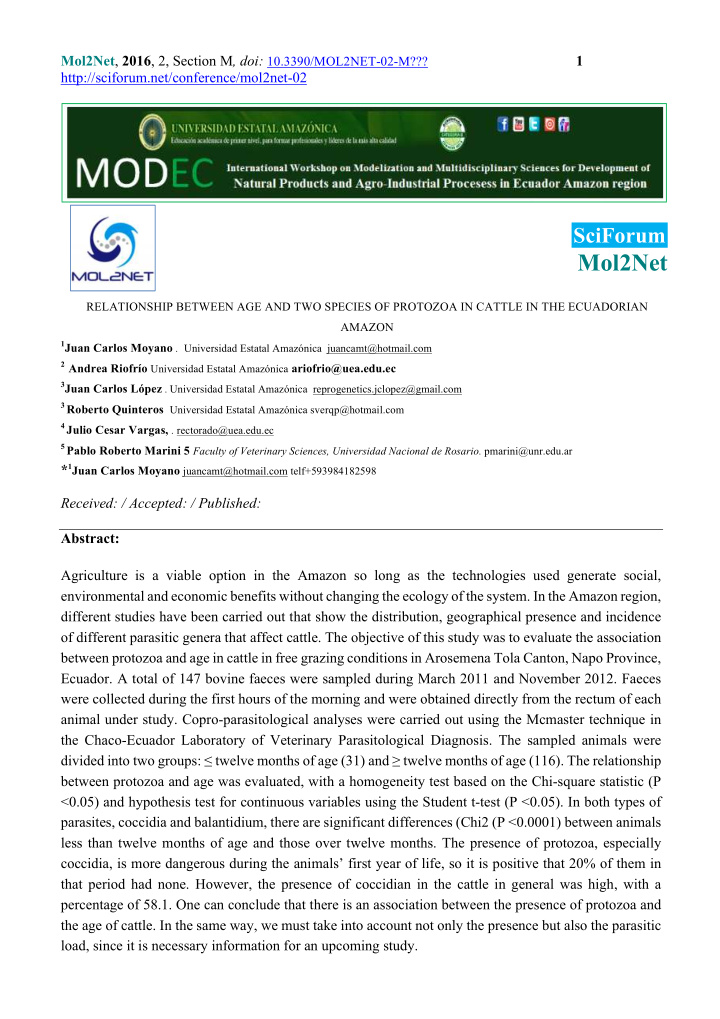



Mol2Net , 2016 , 2, Section M , doi: 10.3390/MOL2NET-02-M??? 1 http://sciforum.net/conference/mol2net-02 SciForum Mol2Net RELATIONSHIP BETWEEN AGE AND TWO SPECIES OF PROTOZOA IN CATTLE IN THE ECUADORIAN AMAZON 1 Juan Carlos Moyano . Universidad Estatal Amazónica juancamt@hotmail.com 2 Andrea Riofrío Universidad Estatal Amazónica ariofrio@uea.edu.ec 3 Juan Carlos López . Universidad Estatal Amazónica reprogenetics.jclopez@gmail.com 3 Roberto Quinteros Universidad Estatal Amazónica sverqp@hotmail.com 4 Julio Cesar Vargas, . rectorado@uea.edu.ec 5 Pablo Roberto Marini 5 Faculty of Veterinary Sciences, Universidad Nacional de Rosario. pmarini@unr.edu.ar * 1 Juan Carlos Moyano juancamt@hotmail.com telf+593984182598 Received: / Accepted: / Published: Abstract: Agriculture is a viable option in the Amazon so long as the technologies used generate social, environmental and economic benefits without changing the ecology of the system. In the Amazon region, different studies have been carried out that show the distribution, geographical presence and incidence of different parasitic genera that affect cattle. The objective of this study was to evaluate the association between protozoa and age in cattle in free grazing conditions in Arosemena Tola Canton, Napo Province, Ecuador. A total of 147 bovine faeces were sampled during March 2011 and November 2012. Faeces were collected during the first hours of the morning and were obtained directly from the rectum of each animal under study. Copro-parasitological analyses were carried out using the Mcmaster technique in the Chaco-Ecuador Laboratory of Veterinary Parasitological Diagnosis. The sampled animals were divided into two groups: ≤ twelve months of age (31) and ≥ twelve months of age (116). The relationship between protozoa and age was evaluated, with a homogeneity test based on the Chi-square statistic (P <0.05) and hypothesis test for continuous variables using the Student t-test (P <0.05). In both types of parasites, coccidia and balantidium, there are significant differences (Chi2 (P <0.0001) between animals less than twelve months of age and those over twelve months. The presence of protozoa, especially coccidia, is more dangerous during the animals’ first year of life, so it is positive that 20% of them in that period had none. However, the presence of coccidian in the cattle in general was high, with a percentage of 58.1. One can conclude that there is an association between the presence of protozoa and the age of cattle. In the same way, we must take into account not only the presence but also the parasitic load, since it is necessary information for an upcoming study.
MOL2NET , 2016 , 2, http://sciforum.net/conference/mol2net-02 2 Keywords: protozoa, cattle, age Introduction: Agriculture is a viable option in the Amazon, so long as technologies that generate social, environmental and economic benefits are used, without modifying the ecology of the system. In the Amazon region, different studies have been carried out that show the distribution, geographical presence and incidence of different parasitic genera that affect cattle. The objective of this study was to evaluate the association between Results and Discussion: protozoa and age in cattle in free grazing conditions. The sampled animals were divided into two groups: ≤ twelve months of age (31) and ≥ twelve Materials and Methods: months of age (116). The relationship between protozoa and age was evaluated, with a The study was carried out in the Arosemena Tola homogeneity test based on the Chi-square statistic Canton, Napo Province, Ecuador. (P <0.05) and hypothesis test for continuous A total of 147 bovine faeces were sampled during variables using the Student t-test (P <0.05). In March 2011 and November 2012. both types of parasites, coccidia and balantidium, Faeces were collected during the first hours of the there are significant differences (Chi2 (P <0.0001) morning and were obtained directly from the between animals less than twelve months of age rectum of each animal under study. Copro- and those over twelve months. parasitological analyses were carried out using the Mcmaster technique in the Chaco-Ecuador The presence of protozoa, especially coccidia, is Laboratory of Veterinary Parasitological more dangerous during the animals’ first year of Diagnosis. life, so it is positive that 20% of them in that period had none. However, the presence of coccidian in the cattle in general was high, with a percentage of 58.1. Conclusions: One can conclude that there is an association between the presence of protozoa and the age of cattle. In the same way, we must take into account not only the presence but also the parasitic load, since it is necessary information for an upcoming study.
MOL2NET , 2016 , 2, http://sciforum.net/conference/mol2net-02 3 References: 1. Díaz, B. Clasificación de la carga parasitaria. Riobamba, Ecuador, sn: 2002. p. 38. 2. Borchert, A. Parasitología Veterinaria , Editorial Acribia, Zaragoza-España: 1975, p. 84-88 3. Cordero Del Campillo, M. Parasitología Veterinaria . Mc. Graw Hill. Madrid España: 1999, p. 87-228. 4. Dehority, B.A. Rumen Microbiology . Nottingham, (UK): Nottingham University Press; 2003. 5. León, K. Prevalencia y determinación de endoparásitos en bovinos del cantón Francisco de Orellana, provincia del Napo. Universidad de Guayaquil (Ecuador). Facultad de Medicina Veterinaria y Zootecnia: 1988. 6. Williams, A.G; Coleman, G.S. The Rumen Protozoa . New York: Springer-Verlag: 1992.
Recommend
More recommend